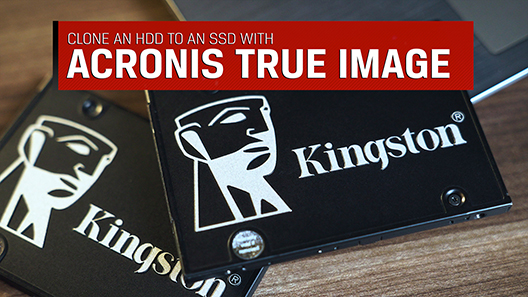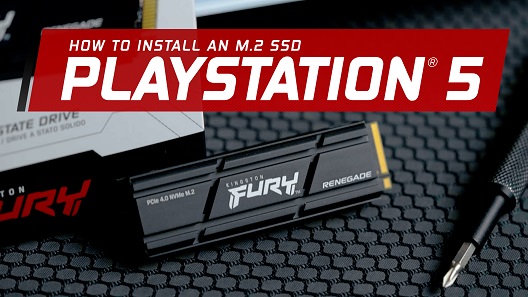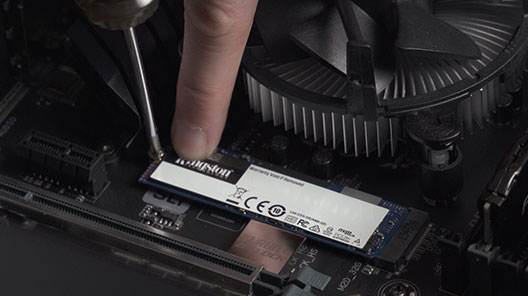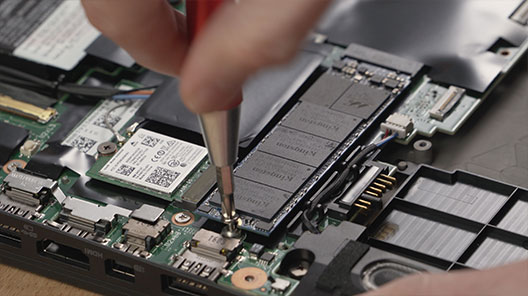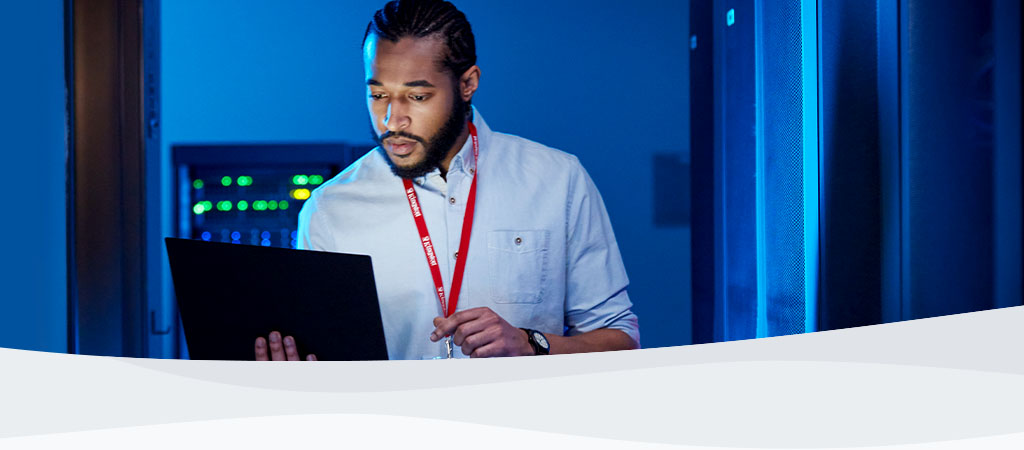
Kingston FURY Renegade PCIe 4.0 NVMe M.2 SSD - Support
Ressourcen
Videos
Häufig gestellte Fragen
FAQ: KSD-200100-FURY-001
War dies hilfreich?
1. Lade den Kingston SSD Manager von https://www.kingston.com/support/technical/ssdmanager herunter, um festzustellen, ob ein Firmware-Update für dein Laufwerk verfügbar ist, und wenn ja, wende das Update an (falls empfohlen).
2. Informiere dich auf der Support-Seite deines Systemherstellers, ob ein BIOS-Update für dein System verfügbar ist.
3. Vergewissere dich, dass die neueste Version deines Betriebssystems genutzt wird und dass keine Aktualisierungen ausstehen.
4. Stelle sicher, dass die neuesten Treiber für dein System verwendet werden. Besuche hierzu die Support-Seite deines Systemherstellers und suche nach den neuesten Treiber-Updates.
Falls nach diesen Schritten immer noch Probleme mit deinem System auftreten, wende dich bitte an den technischen Support von Kingston.
FAQ: KSD-012010-001-21
War dies hilfreich?
Dies ist bei Flashspeichern üblich, egal ob es sich um interne SSDs oder externe USB-Sticks handelt, und liegt zum Teil daran, dass die Hersteller von Flashspeichern im Vergleich zu Festplatten mit sich drehenden Platten unterschiedliche Berechnungsmethoden für Megabyte verwenden. Festplattenhersteller berechnen ein Megabyte (oder 1.000x1.000 Byte) als 1.000KB, während die binäre Berechnung für Flash-basierten Speicher 1.024KB beträgt.
Beispiel: Für ein Flash-basiertes 1TB-Speichergerät berechnet Windows eine Kapazität von 931,32GB. (1.000.000.000.000÷1.024÷1.024÷1.024=931,32GB).
Außerdem reserviert Kingston einen Teil der aufgelisteten Kapazität für die Formatierung und andere Funktionen wie Firmware und/oder controllerspezifische Informationen, wodurch ein Teil der aufgelisteten Kapazität nicht für die Datenspeicherung zur Verfügung steht.
FAQ: KDT-010611-GEN-06
War dies hilfreich?
FAQ: KSD-001525-001-00
War dies hilfreich?
FAQ: KSD-012010-001-18
War dies hilfreich?
FAQ: KSD-012010-001-00
War dies hilfreich?
FAQ: KSD-012010-001-01
War dies hilfreich?
FAQ: KSD-012010-001-03
War dies hilfreich?
- Vergewissere dich, dass das System-BIOS deine neue SSD erkennt. Falls nicht, besuche die Website des Motherboard-/Systemherstellers, um zu überprüfen, ob ein neues BIOS verfügbar ist.
- Vergewissere dich, dass deine BIOS-Einstellungen so konfiguriert sind, dass sie eine neue NVMe SSD akzeptieren.
- Stelle sicher, dass dein Zielbetriebssystem NVMe SSDs unterstützt (Bsp: Windows 8 oder höher).
Hinweis: Kingston SSDs benötigen keine zusätzlichen Treiber für den Betrieb.
FAQ: KSD-012010-001-05
War dies hilfreich?
https://support.microsoft.com/en-us/topic/update-to-add-native-driver-support-in-nvm-express-in-windows-7-and-windows-server-2008-r2-03cd423b-d42e-66c2-722b-019d16455a6b
FAQ: KSD-012010-001-06
War dies hilfreich?
FAQ: KSD-012010-001-07
War dies hilfreich?
Wenn das Laufwerk im BIOS vorhanden ist, muss die Festplatte möglicherweise im Betriebssystem initialisiert werden.
Für Windows:
1. Schritt: Vergewissere dich, dass das Laufwerk ordnungsgemäß angeschlossen ist, schalte das System ein und starte dann das Windows-Betriebssystem.
2. Schritt: Drücke die Tasten Windows + X und wähle die Datenträgerverwaltung.
3. Schritt: Wenn die SSD neu und noch nicht initialisiert ist, erscheint ein Popup-Fenster mit der Aufschrift „Datenträger initialisieren“.
4. Schritt: Wähle zwischen:
MBR (Master Boot Record): Geeignet für Laufwerke unter 2TB und ältere Systeme.
GPT (GUID-Partitionstabelle): Empfohlen für moderne Systeme und Laufwerke mit mehr als 2TB.
5. Schritt: Auf „OK“ klicken, um die Festplatte zu initialisieren.
6. Schritt: Nach der Initialisierung wird die SSD als „Nicht zugewiesen“ angezeigt. Klicke mit der rechten Maustaste darauf und wähle „Neues einfaches Laufwerk“.
7. Schritt: Folge den Anweisungen auf dem Bildschirm, um die SSD zu formatieren und ihr einen Laufwerksbuchstaben zuzuweisen.
Für MacOS:
1. Schritt: Vergewissere dich, dass das Laufwerk ordnungsgemäß angeschlossen ist, schalte das System ein und starte dann das Mac-Betriebssystem.
2. Schritt: Öffne das Festplatten-Dienstprogramm (über Spotlight mit der Tastenkombination Cmd + Leertaste und der Eingabe von „Festplatten-Dienstprogramm“ zu finden).
3. Schritt: Wähle im linken Fensterbereich deine SSD aus.
4. Schritt: Klicke auf „Löschen“.
5. Schritt: Gib einen Namen für das Laufwerk ein, und wähle unter „Formatieren“:
APFS für neuere Macs und SSDs.
Mac OS Extended (Journaled) für ältere Systeme oder HDDs.
6. Schritt: Klicke auf „Löschen“. Sobald der Vorgang abgeschlossen ist, ist die SSD einsatzbereit.
Für Linux:
1. Schritt: Vergewissere dich, dass das Laufwerk ordnungsgemäß angeschlossen ist, schalte das System ein und starte dann das Linux-Betriebssystem.
2. Schritt: Öffne ein Terminal.
3. Schritt: Gib sudo fdisk -l ein, um alle angeschlossenen Laufwerke aufzulisten. Identifiziere deine SSD anhand ihrer Größe und notiere den Gerätenamen, z.B. /dev/sdb.
4. Schritt: Initialisiere die SSD mit fdisk oder parted. Hier ist eine grundlegende Anleitung für die Verwendung von fdisk:
Gib sudo fdisk /dev/sdb ein (ersetze /dev/sdb durch den Gerätenamen deiner SSD).
Drücke g, um eine neue GPT-Partitionstabelle zu erstellen.
Drücke n, um eine neue Partition zu erstellen. Befolge die Anweisungen, um die Größe und den Typ anzugeben.
Drücke w, um die Änderungen zu übernehmen.
5. Schritt: Formatiere die neue Partition auf der SSD (z.B. /dev/sdb1). Die Partition kann wie folgt mit dem Dateisystem deiner Wahl formatiert werden:
Für ext4: sudo mkfs.ext4 /dev/sdb1
Für ext3: sudo mkfs.ext3 /dev/sdb1
Für FAT32: sudo mkfs.vfat /dev/sdb1
6. Schritt: Mounten der SSD:
Erstellen eines Mounting-Punkts: sudo mkdir /mnt/myssd
Mounten der SSD: sudo mount /dev/sdb1 /mnt/myssd
Denke daran, /dev/sdb1 durch den Namen der Partition deiner SSD zu ersetzen.
FAQ: KSD-012010-001-15
War dies hilfreich?
https://www.kingston.com/blog/pc-performance/two-types-m2-vs-ssd
FAQ: KSD-012010-001-16
War dies hilfreich?
FAQ: KSD-200100-FURY-001
War dies hilfreich?
Wenn deine SSD eine neue Firmware benötigt, erhältst du eine Benachrichtigung, wenn die SSD Manager Software von Kingston ausgeführt wird, die hier zu finden ist: www.kingston.com/ssdmanager
FAQ: KSD-012010-001-11
War dies hilfreich?
M.2 ist ein physischer Formfaktor. SATA und PCIe beziehen sich jeweils auf die Speicherschnittstelle. Der Hauptunterschied liegt in der Leistung und dem Protokoll (Sprache) der M.2-SSD.
Die Spezifikationen der M.2 wurden so konzipiert, dass sie sowohl eine SATA- als auch eine PCIe-Schnittstelle für SSDs aufnehmen kann. M.2-SATA-SSDs verwenden denselben Controller, der bei typischen 2,5-Zoll-SATA-SSDs verwendet wird. M.2-PCIe-SSDs werden einen Controller verwenden, der speziell zur Unterstützung des PCIe-Protokolls konzipiert wurde. Eine M.2-SSD kann nur ein Protokoll unterstützen. Jedoch haben verschiedene Systeme M.2-Steckplätze, die sowohl SATA als auch PCIe unterstützen können.
FAQ: KSD-004005-001-00
War dies hilfreich?
https://www.kingston.com/blog/pc-performance/nvme-vs-sata
FAQ: KSD-012010-001-19
War dies hilfreich?
FAQ: KSD-012010-001-04
War dies hilfreich?
Wenn deine SSD eine neue Firmware benötigt, erhältst du eine Benachrichtigung, wenn die SSD Manager Software von Kingston ausgeführt wird, die hier zu finden ist: www.kingston.com/ssdmanager
FAQ: KSD-012010-001-11
War dies hilfreich?
FAQ: KSD-012010-001-12
War dies hilfreich?
FAQ: KSD-012010-001-13
War dies hilfreich?
FAQ: KSD-012010-001-14
War dies hilfreich?
FAQ: KSD-012010-001-04
War dies hilfreich?
- Vergewissere dich, dass das System-BIOS deine neue SSD erkennt. Falls nicht, besuche die Website des Motherboard-/Systemherstellers, um zu überprüfen, ob ein neues BIOS verfügbar ist.
- Vergewissere dich, dass deine BIOS-Einstellungen so konfiguriert sind, dass sie eine neue NVMe SSD akzeptieren.
- Stelle sicher, dass dein Zielbetriebssystem NVMe SSDs unterstützt (Bsp: Windows 8 oder höher).
Hinweis: Kingston SSDs benötigen keine zusätzlichen Treiber für den Betrieb.
FAQ: KSD-012010-001-05
War dies hilfreich?
https://www.kingston.com/blog/pc-performance/two-types-m2-vs-ssd
FAQ: KSD-012010-001-16
War dies hilfreich?
Wenn das Laufwerk im BIOS vorhanden ist, muss die Festplatte möglicherweise im Betriebssystem initialisiert werden.
Für Windows:
1. Schritt: Vergewissere dich, dass das Laufwerk ordnungsgemäß angeschlossen ist, schalte das System ein und starte dann das Windows-Betriebssystem.
2. Schritt: Drücke die Tasten Windows + X und wähle die Datenträgerverwaltung.
3. Schritt: Wenn die SSD neu und noch nicht initialisiert ist, erscheint ein Popup-Fenster mit der Aufschrift „Datenträger initialisieren“.
4. Schritt: Wähle zwischen:
MBR (Master Boot Record): Geeignet für Laufwerke unter 2TB und ältere Systeme.
GPT (GUID-Partitionstabelle): Empfohlen für moderne Systeme und Laufwerke mit mehr als 2TB.
5. Schritt: Auf „OK“ klicken, um die Festplatte zu initialisieren.
6. Schritt: Nach der Initialisierung wird die SSD als „Nicht zugewiesen“ angezeigt. Klicke mit der rechten Maustaste darauf und wähle „Neues einfaches Laufwerk“.
7. Schritt: Folge den Anweisungen auf dem Bildschirm, um die SSD zu formatieren und ihr einen Laufwerksbuchstaben zuzuweisen.
Für MacOS:
1. Schritt: Vergewissere dich, dass das Laufwerk ordnungsgemäß angeschlossen ist, schalte das System ein und starte dann das Mac-Betriebssystem.
2. Schritt: Öffne das Festplatten-Dienstprogramm (über Spotlight mit der Tastenkombination Cmd + Leertaste und der Eingabe von „Festplatten-Dienstprogramm“ zu finden).
3. Schritt: Wähle im linken Fensterbereich deine SSD aus.
4. Schritt: Klicke auf „Löschen“.
5. Schritt: Gib einen Namen für das Laufwerk ein, und wähle unter „Formatieren“:
APFS für neuere Macs und SSDs.
Mac OS Extended (Journaled) für ältere Systeme oder HDDs.
6. Schritt: Klicke auf „Löschen“. Sobald der Vorgang abgeschlossen ist, ist die SSD einsatzbereit.
Für Linux:
1. Schritt: Vergewissere dich, dass das Laufwerk ordnungsgemäß angeschlossen ist, schalte das System ein und starte dann das Linux-Betriebssystem.
2. Schritt: Öffne ein Terminal.
3. Schritt: Gib sudo fdisk -l ein, um alle angeschlossenen Laufwerke aufzulisten. Identifiziere deine SSD anhand ihrer Größe und notiere den Gerätenamen, z.B. /dev/sdb.
4. Schritt: Initialisiere die SSD mit fdisk oder parted. Hier ist eine grundlegende Anleitung für die Verwendung von fdisk:
Gib sudo fdisk /dev/sdb ein (ersetze /dev/sdb durch den Gerätenamen deiner SSD).
Drücke g, um eine neue GPT-Partitionstabelle zu erstellen.
Drücke n, um eine neue Partition zu erstellen. Befolge die Anweisungen, um die Größe und den Typ anzugeben.
Drücke w, um die Änderungen zu übernehmen.
5. Schritt: Formatiere die neue Partition auf der SSD (z.B. /dev/sdb1). Die Partition kann wie folgt mit dem Dateisystem deiner Wahl formatiert werden:
Für ext4: sudo mkfs.ext4 /dev/sdb1
Für ext3: sudo mkfs.ext3 /dev/sdb1
Für FAT32: sudo mkfs.vfat /dev/sdb1
6. Schritt: Mounten der SSD:
Erstellen eines Mounting-Punkts: sudo mkdir /mnt/myssd
Mounten der SSD: sudo mount /dev/sdb1 /mnt/myssd
Denke daran, /dev/sdb1 durch den Namen der Partition deiner SSD zu ersetzen.
FAQ: KSD-012010-001-15
War dies hilfreich?
FAQ: KSD-012010-001-18
War dies hilfreich?
FAQ: KSD-012010-001-04
War dies hilfreich?
FAQ: KSD-012010-001-00
War dies hilfreich?
- Vergewissere dich, dass das System-BIOS deine neue SSD erkennt. Falls nicht, besuche die Website des Motherboard-/Systemherstellers, um zu überprüfen, ob ein neues BIOS verfügbar ist.
- Vergewissere dich, dass deine BIOS-Einstellungen so konfiguriert sind, dass sie eine neue NVMe SSD akzeptieren.
- Stelle sicher, dass dein Zielbetriebssystem NVMe SSDs unterstützt (Bsp: Windows 8 oder höher).
Hinweis: Kingston SSDs benötigen keine zusätzlichen Treiber für den Betrieb.
FAQ: KSD-012010-001-05
War dies hilfreich?
FAQ: KSD-012010-001-03
War dies hilfreich?
FAQ: KSD-012010-001-01
War dies hilfreich?
Wenn das Laufwerk im BIOS vorhanden ist, muss die Festplatte möglicherweise im Betriebssystem initialisiert werden.
Für Windows:
1. Schritt: Vergewissere dich, dass das Laufwerk ordnungsgemäß angeschlossen ist, schalte das System ein und starte dann das Windows-Betriebssystem.
2. Schritt: Drücke die Tasten Windows + X und wähle die Datenträgerverwaltung.
3. Schritt: Wenn die SSD neu und noch nicht initialisiert ist, erscheint ein Popup-Fenster mit der Aufschrift „Datenträger initialisieren“.
4. Schritt: Wähle zwischen:
MBR (Master Boot Record): Geeignet für Laufwerke unter 2TB und ältere Systeme.
GPT (GUID-Partitionstabelle): Empfohlen für moderne Systeme und Laufwerke mit mehr als 2TB.
5. Schritt: Auf „OK“ klicken, um die Festplatte zu initialisieren.
6. Schritt: Nach der Initialisierung wird die SSD als „Nicht zugewiesen“ angezeigt. Klicke mit der rechten Maustaste darauf und wähle „Neues einfaches Laufwerk“.
7. Schritt: Folge den Anweisungen auf dem Bildschirm, um die SSD zu formatieren und ihr einen Laufwerksbuchstaben zuzuweisen.
Für MacOS:
1. Schritt: Vergewissere dich, dass das Laufwerk ordnungsgemäß angeschlossen ist, schalte das System ein und starte dann das Mac-Betriebssystem.
2. Schritt: Öffne das Festplatten-Dienstprogramm (über Spotlight mit der Tastenkombination Cmd + Leertaste und der Eingabe von „Festplatten-Dienstprogramm“ zu finden).
3. Schritt: Wähle im linken Fensterbereich deine SSD aus.
4. Schritt: Klicke auf „Löschen“.
5. Schritt: Gib einen Namen für das Laufwerk ein, und wähle unter „Formatieren“:
APFS für neuere Macs und SSDs.
Mac OS Extended (Journaled) für ältere Systeme oder HDDs.
6. Schritt: Klicke auf „Löschen“. Sobald der Vorgang abgeschlossen ist, ist die SSD einsatzbereit.
Für Linux:
1. Schritt: Vergewissere dich, dass das Laufwerk ordnungsgemäß angeschlossen ist, schalte das System ein und starte dann das Linux-Betriebssystem.
2. Schritt: Öffne ein Terminal.
3. Schritt: Gib sudo fdisk -l ein, um alle angeschlossenen Laufwerke aufzulisten. Identifiziere deine SSD anhand ihrer Größe und notiere den Gerätenamen, z.B. /dev/sdb.
4. Schritt: Initialisiere die SSD mit fdisk oder parted. Hier ist eine grundlegende Anleitung für die Verwendung von fdisk:
Gib sudo fdisk /dev/sdb ein (ersetze /dev/sdb durch den Gerätenamen deiner SSD).
Drücke g, um eine neue GPT-Partitionstabelle zu erstellen.
Drücke n, um eine neue Partition zu erstellen. Befolge die Anweisungen, um die Größe und den Typ anzugeben.
Drücke w, um die Änderungen zu übernehmen.
5. Schritt: Formatiere die neue Partition auf der SSD (z.B. /dev/sdb1). Die Partition kann wie folgt mit dem Dateisystem deiner Wahl formatiert werden:
Für ext4: sudo mkfs.ext4 /dev/sdb1
Für ext3: sudo mkfs.ext3 /dev/sdb1
Für FAT32: sudo mkfs.vfat /dev/sdb1
6. Schritt: Mounten der SSD:
Erstellen eines Mounting-Punkts: sudo mkdir /mnt/myssd
Mounten der SSD: sudo mount /dev/sdb1 /mnt/myssd
Denke daran, /dev/sdb1 durch den Namen der Partition deiner SSD zu ersetzen.
FAQ: KSD-012010-001-15
War dies hilfreich?
https://www.kingston.com/blog/pc-performance/two-types-m2-vs-ssd
FAQ: KSD-012010-001-16
War dies hilfreich?
FAQ: KSD-012010-001-14
War dies hilfreich?
FAQ: KSD-012010-001-13
War dies hilfreich?
FAQ: KSD-012010-001-12
War dies hilfreich?
Wenn deine SSD eine neue Firmware benötigt, erhältst du eine Benachrichtigung, wenn die SSD Manager Software von Kingston ausgeführt wird, die hier zu finden ist: www.kingston.com/ssdmanager
FAQ: KSD-012010-001-11
War dies hilfreich?
FAQ: KSD-012010-001-07
War dies hilfreich?
https://support.microsoft.com/en-us/topic/update-to-add-native-driver-support-in-nvm-express-in-windows-7-and-windows-server-2008-r2-03cd423b-d42e-66c2-722b-019d16455a6b
FAQ: KSD-012010-001-06
War dies hilfreich?
FAQ: KSD-012010-001-18
War dies hilfreich?
Still Need Assistance?
E-Mail an Technischen Support
Füllen Sie ein kurzes Formular aus, um einen Antrag per E-Mail zu stellen.
E-Mail-AdresseRufen Sie den Technischen Support an.
Montag–Freitag 6 a.m.-5 p.m. PT
+1 (800)435-0640
